Saint Louis, Guet Ndar and the shifting ground in the Senegal River delta

On the road, we saw many signs of the contrasting developments, new constructions and wealth generation on one side and utter delapidation and plastic pollution on the other.
Making it finally to Saint Louis, we caught first glances of its old colonial island town, the successful fisheries managed out of the overcrowded conditions in Guet Ndar and seemed to hear the sounds of the famous jazz festival that attracts aficionados from all over the place to Saint Louis in May every year.
The beauty of modern travel is that one can get a first visual impression 'from above' even before getting anywhere. It helps making sense of the more visceral experience on the ground.
The Google Earth image shows the colonial part of Saint Louis perched on the island connected by a bridge to the Langue de Barbarie in the lower left part of the image and the Faidherb Bridge connecting it to modern-day Saint Louis above, all set in the ever moving land- and seascape of the Senegal River Delta.
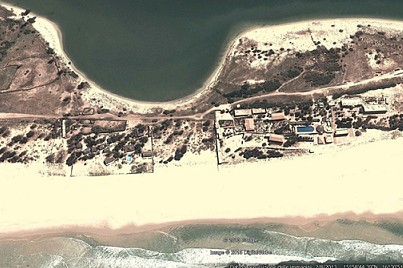
Much of the Langue de Barbarie is densely populated, particularly the part occupied by the crowded Guet Ndar fishing community opposite the island of Saint Louis.
The remaining space is constituted by a vast cemetry, a so-called hydrobase, sprawling hotel constructions shown in greater resolution in the image to the right and a protected area at the tip of the peninsula.
phocamaps view=map|id=2}
The fishery of Guet Ndar is probably the biggest in the country and not confined to this location. The fishermen there have a long-standing reputation as recalled by Malick Gueye, one of their historical leaders and at 92 years still an imman concerned about peaceful coexistence between the religions and communities and concerned about reigning in excessive and destructive fishing practices.
Malick himself, with a few fellow fishermen from the community, was sent by the government after independence as development assistant to Benin, in the Gulf of Guinea, to teach the local fishers. The interview with the story of his extra-ordinary life is available here.

The fishing crews of Guet Ndar have signed up in the past with industrial boat owners to be taken as far south as Guinea with their boats loaded on a mothership. Several crews also regularly operate out of Nouadhibou in Mauritania to service the European market more directly through Las Palmas. Much of the seasonal sardinella caught in the encircling nets and landed on the beach opposite the Saint Louis island goes nowadays in refrigerated trucks straight into Mali. What can be processed locally is handled by the women of Guet Ndar. They work in very difficult sanitary and space conditions on the beach.
As municipal adviser in Saint Louis, Awa Seye, represents the interests of her community in the council and vis-à-vis the administration. On the top of her agenda are three concerns:
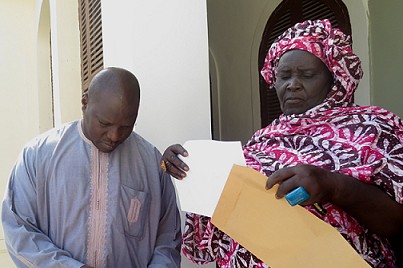
Concern number one is without doubt the issue of safety at sea right now. Some two dozen men lost at sea in the first months of 2013 is a heavy death toll affecting many of the families in Guet Ndar. The administration opened the narrowest part of the lower part of the Langue de Barbarie in October 2012 to prevent heavy flooding in town. Unexpectedly, instead of closing the new gap quickly through the prevailing current and sand transport the opening widened to perhaps 200 meters now and changed the flows and position of sandbanks. Even with safety equipment such as gps and life vests several accidents cost the lives of fishing crews.
It's a much debated problem, but somehow the port authority, security forces, several other public services, the university researchers, NGOs and fishermen seem not yet have come together in one place in the common search of viable answers to these deadly dangers.
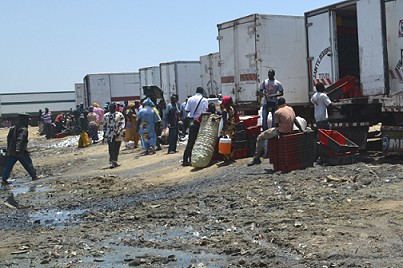
Concern number two is the problem of maternal and infant health and public health. Suffering herself several still births, Awa had the chance to be trained as a midwife in her earlier years. She took it with both hands and has since delivered many babies, initially even in her own room. She is still working on how to improve health services in Guet Ndar and encourages systematic schooling of kids, particularly girls. She wants them be better prepared and able to make better informed choices. Some 22 girls are named after her in recognition of her role as midwife and for outstanding community service.
Concern number three is to ensure sufficient and decent working space for the women fish processors and vendors. It comes down to a whole host of issues. The first is to get a bigger say in the way the very limited space on Langue de Barbarie is allocated and managed. The women affirm their right to adequate space to develop their business. They are not happy with how the positioning of refrigerated trucks is managed in partial disregard of existing rules. The biggest thorn in the side of the women are, however, the land claims of the tourist operators.
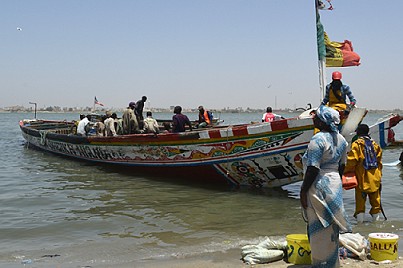
Not unlike developments in other parts of Senegal and other countries, there is growing competition between traditional fisheries, infrastructure development and a form of tourism that is in the hands of outside investors and which leaves no benefits in the community. On the contrary, as only too often happens, the tourists need their own security, food and stereotyped vistas and leave behind their trash. They may take folkloristic pictures from their four-wheel cars of the colourful boats and the bustling life on the beach in Guet Ndar, but the'd rather not stop to buy anything in the community.
It's a tricky issue. More than one fishing community has hoped that tourism might bring alternative sources of income when they faced the low end of the boom and bust cycle. But unless they were able to muster the skills and capacities to run at least part of the business themselves this has often not materialised. When traditional fishing communities did not have the political clout to influence the frame conditions of desired diversifications, they have lost out to outside investors with deeper pockets. These considerations are also on Awa's mind when she casts around for securing a more important say for the Guet Ndar community in the public and private discussions affecting safety at sea and all the other vital concerns of her people.
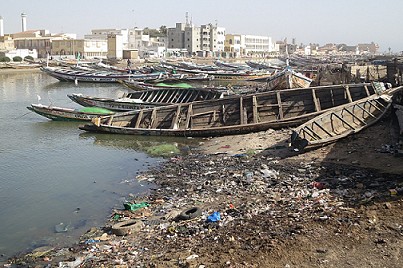
Meanwhile the community have their own set of challenges, which do not depend exclusively on cooperation with others. Keeping the working spaces on the beach clean is one such challenge as a view from the bridge leading towards Guet Ndar shows.
Becoming more actively engaged in shunning the use of prohibited monofilament nets. You can see them about openly. So, there seems to be little sense of wrong and even less enforcement of this sort of rules. It's an illustration that the community is not homogeneous and issues get prioritised differently by different families or at different times depending on the shifting ground of how interests are perceived.
Sadly, also the small, nominally protected area at the remaining tip of Langue de Barbarie seems not to be immune - neither from being littered from one side to the other nor from extractive activities. During the visit with Awa, we found a crew happily operating nylon nets from a boat inside the protected area and also saw individual fishers working from the shore.
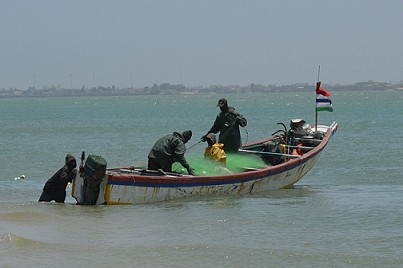
In the face of harsh survival conditions both authorities and fellow fishermen tend to turn a blind eye on individuals ignoring the rules. This is not confined to Senegal. It might, however, be worth explaining that protected areas - when respected - demonstrably serve as an insurance policy against the ups and downs of nature and the fishery itself. Moreover, the strategy of migration on a seasonal basis into neighbouring countries or areas, which helped to cope low local resource abundance is becoming more problematic as extraction is now heavy in most places and is leading to a general trend of resource depletion. In the past, migration was a rational response to deal with the bust of the cycle or simply respond to the uncertainty and natural resource fluctuations. Needless to say, that depletion tends to amplify the fluctuations, while healthy ecosystems are usually much more robust and stable. So migration might become more of a double-sided sword, not to mention the effects on the fisherfolk in host countries and regions.
In a short time we got some initial impressions about the multi-facetted challenges of organising sustainable ways of living on the coast and with its renewable resources. The short tour raised more questions than we could possible answer. One thing seems certain, the need for broader-based dialogue.
We echo Awa Seye's suggestion to create a dialogue space giving all parties concerned a voice, but also helping to take care that existing rules get better enforced. She thinks that this would help a lot in reducing mistrust between the authorities and the fishing communities in Saint Louis and elsewhere. She is also convinced of the need to engage more strongly in public debate and participation. It would allow for a greater role in shaping the future of this vital economy and culture of the city of Saint Louis and the entire country.
Text by Cornelia E Nauen, Photos by Paolo Bottoni.








